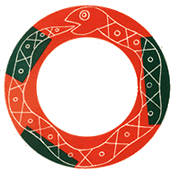Mother's
Storehouse
The Universal Cycle

Just to give you an impression of the
All-Embracing Womb
and Her spiritual-religious-cultural-psychological dimensions
The Original
Tradition
Beyond any beginning there is Absolute Emptiness. It is the Vacuum,
the Abyss of the universe, the Cosmic Womb embracing all existence, the Origin of the Law
of the Universe. Early mankind - the great matriarchal cultures - acknowledged Her as the
Ultimate Reality, hence calling Her the Great Mother.
Emptiness beyond
Emptiness
Some religions have still connections to the Orginal Great Mother.
Despite patriarchal manipulations some have even preserved original meaning. However, the
words and concepts have often changed. Lao Tze was still entirely dedicated to the Old
Tradition - hence his Tao Te Ching breathes the beauty of "old times", while the
Buddha prefered to use abstract terms. In Taoism Emptiness is
called Tao (Womb), in Buddhism She is called Nirvana.
The Law of
Creation/Preservation and Destruction
The Ultimate includes the primary Law of the Universe, that of the Unity of Creation,
Preservation and Destruction. Everything without any exception is ruled by it. This
universal Law is especially emphasized by Hinduism. The original Mother
was replaced by patriarchal Divinity having three aspects: Brahman (the Creator), Vishnu
(the Preserver) and Shiva (the Destroyer).
Goddesses
These are aspects of the original Great
Mother. The latter including dearth, rebirth and interconnectedness. Though disintegration
of the Mother, parts splitt off, starting to live a life on their own. It resulted in all
kinds of "entities", representing aspects like fertility, protectress against
illnesses, promotress of prosperity, savioress or also devouring ones, like the Hindu
Goddess Kali. Goddesses are worshipped by Pagan and Wicca groups.
The One God
Uninterruptedly emptying Herself beyond Emptiness - in Her incomprehensible
Vacuum - the Divine is born, while returning to Her in the selfsame Eternal Moment. It is
the Great Transparency, the Eternal Light, the Omnipresent Being, the Object of devotion
of all great monotheistic religions e.g. Judaism, Christianity and Islam.
The Self
This includes the birth of the Divine Spark as it
can be found in the Gnostic and Mystical traditions of all major
religions, alchemy, and e.g. spiritual humanism and "common" individuals.
Including famous teachers like Hermes Trismegistos, Pythagoras, Sokrates, Plato, Plotinos,
Valentinus, Eckehart, Giordano Bruno, Spinoza, Mme Guyon, and many more....
The harmony of
macro- and microcosmos
The notion of harmony between macro- and microcosmos is widespread. It assumes that the
Law of Heaven is (and thus should be) reflected by the culture, the social structure and
the behavior of people, an ideal mostly symbolized by a "heavenly" ruler. This
concept of harmony is most outspoken in Javanese culture.
The bipolarity of
existence
Once expressing Itself in the visible world, the Divine (Tao) separates Itself in
the unity of opposites, two complementary forces explaining the origin of the world.
Heaven and earth are the physical representation of yin and yang, symbolizing the
intercourse of female and male. It is a cornerstone of Chinese universism.
The ten thousand
things: spirited nature
After the Divine (Great Spirit) has manifested, the visible world separates
itself in the "ten thousand things": the universe. Nature is spirited, the
"body of the Divine", an inseparate part of the Whole. Every living creature has
its spirit rooted in the great Spirit and its body rooted in the earth. It is the main
belief of Shinto (kami) and indigenous peoples around the world.
Spirits or Ghosts
The "spirits" also constitute the human environment, both within and
without. Depending on culture, education and psychology certain aspects of personality
(spirits, subpersonalities, dreams, voices) are accepted and beneficial, while others are
excluded thus becoming harmful. E.g. African and Creole practices like
voodoo, brua and winti are dealing with them.
The ego
Finally the I ("ego") became separated from the Self. This
disconnected, alienated part of personality is characteristic to the Western mind.
It started a life of its own, on its own and for its own. It had to rely on ratio-only
with humanism as its positive outcome. However, because of its inability to return to the
Source it more and more blew itself up. It is the driving force behind materialism,
expansion and exploitation. Thrown upon itself it desperately longs for reuniting with the
Origin, thus closing the Cycle....

|

